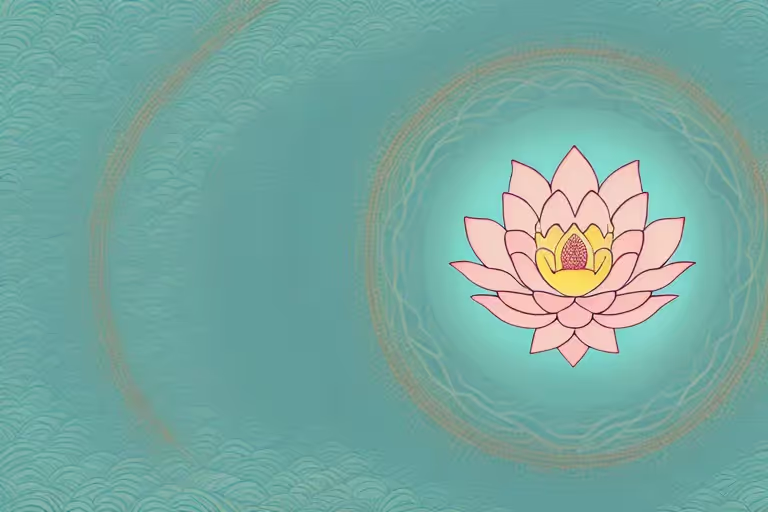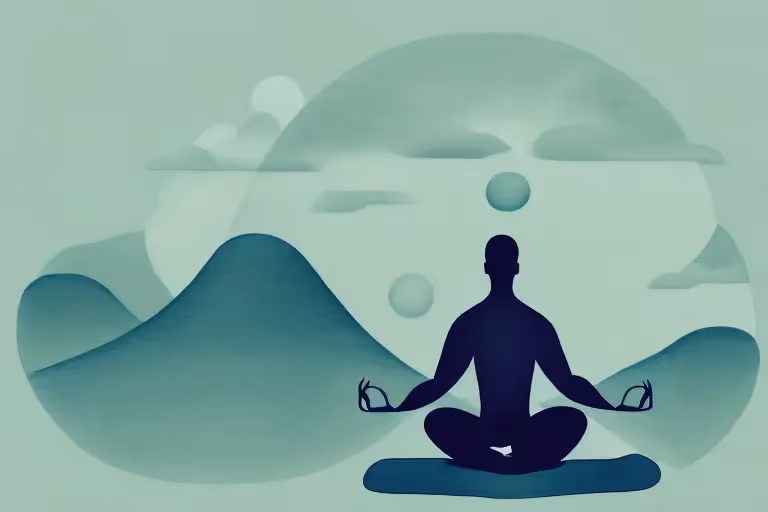In today's fast-paced and chaotic world, finding inner peace and grounding seems more important than ever. Somatic meditation offers a unique approach to mindfulness, allowing us to tap into our body's wisdom to cultivate a deeper sense of presence and connection. In this article, we will explore the concept of somatic meditation, its connection to mindfulness, the process of practicing it, the benefits it offers, and common misconceptions surrounding it. So, let's dive into the world of somatic meditation and discover how it can help us embrace mindfulness in the body.
Understanding Somatic Meditation
At its core, somatic meditation involves bringing awareness to the sensations, movements, and experiences within our body as a means of cultivating mindfulness. Unlike traditional meditation practices that focus solely on the mind, somatic meditation invites us to shift our attention to the physical sensations and movements that arise in the present moment. By doing so, we can develop a profound sense of embodiment and connection with ourselves and the world around us.
Somatic meditation is a practice that goes beyond the surface level of our physical bodies. It delves into the depths of our being, exploring the intricate relationship between the mind and body. Through this practice, we learn to listen to the whispers of our body, to honor its wisdom, and to embrace the fullness of our human experience.
The Concept of Somatic Meditation
Somatic meditation is rooted in the belief that our bodies hold immense wisdom and intelligence. By tuning into the physical sensations, we can access a wealth of information that can guide us in living more fully and authentically. This practice is not about finding a quiet escape from the external world but rather about embracing the full range of our embodied experience, including both pleasure and pain.
When we engage in somatic meditation, we embark on a journey of self-discovery. We become curious explorers of our own bodies, observing the subtle nuances of sensation, the ebb and flow of breath, and the ever-changing landscape of our physical being. Through this process, we develop a deep sense of trust in our bodies and learn to navigate the complexities of our inner world with grace and compassion.
The History and Evolution of Somatic Meditation
Somatic meditation draws inspiration from various contemplative traditions, including Buddhism and yoga. Over the centuries, different techniques and approaches have emerged, all with the common goal of integrating the mind and body. Today, somatic meditation has evolved into a practice that is accessible to people from all walks of life, regardless of their spiritual or religious background.
In ancient Buddhist traditions, somatic meditation was seen as a path to enlightenment, a way of transcending the limitations of the physical body and connecting with the universal consciousness. Yogic traditions, on the other hand, viewed somatic meditation as a means of harmonizing the body and mind, cultivating balance and inner peace.
As the practice of somatic meditation spread across different cultures and traditions, it underwent various adaptations and refinements. Modern-day practitioners have integrated scientific research and psychological insights into the practice, enriching its depth and breadth. Today, somatic meditation is not limited to monastic settings or esoteric circles but has become a mainstream practice embraced by individuals seeking holistic well-being and personal growth.
Through the ages, somatic meditation has proven to be a powerful tool for self-transformation. It offers a pathway to self-awareness, self-acceptance, and self-empowerment. By engaging in this practice, we embark on a journey of self-discovery, unraveling the mysteries of our bodies and minds, and uncovering the profound interconnectedness of all things.
The Connection between Mindfulness and Somatic Meditation
Mindfulness is a key component of somatic meditation. It involves paying attention to the present moment, non-judgmentally, and with a sense of curiosity and acceptance. When we practice mindfulness in the context of somatic meditation, we direct our attention to the physical sensations and experiences unfolding in the body, rather than getting lost in our thoughts or emotions.
Defining Mindfulness in the Context of Somatic Meditation
In somatic meditation, mindfulness is about developing an intimate relationship with the body and its sensations. It is about observing the ever-changing landscape of physical experiences without getting caught up in judgments or interpretations. By cultivating this kind of mindfulness, we can become more attuned to the subtle messages our body communicates to us, helping us navigate life with greater clarity and wisdom.
When we practice somatic meditation, we bring our awareness to the sensations in our body. We may notice the feeling of our feet on the ground, the rise and fall of our breath, or the subtle tingling in our fingertips. By focusing on these physical sensations, we can anchor ourselves in the present moment and cultivate a deep sense of presence.
As we continue to practice somatic meditation, we may start to notice patterns in our physical sensations. We might observe that certain emotions are accompanied by tension in our shoulders or a tightness in our chest. By developing mindfulness in the context of somatic meditation, we can begin to recognize these patterns and gain insight into the mind-body connection.
The Role of Mindfulness in Somatic Meditation
Mindfulness serves as a powerful tool in somatic meditation, enabling us to bring our attention back to the present moment whenever it wanders. Through mindfulness, we can develop a deep sense of self-awareness and compassion towards ourselves and others. The practice of mindfulness also fosters a greater sense of calm, resilience, and equanimity, enabling us to respond to life's challenges with grace and clarity.
When we practice somatic meditation with mindfulness, we learn to approach our physical sensations with curiosity and non-judgment. Rather than labeling a sensation as "good" or "bad," we simply observe it as it is, allowing it to unfold and change without resistance. This gentle and accepting attitude towards our physical experiences can have a profound impact on our overall well-being.
Through the practice of somatic meditation, we can develop a deeper connection with our bodies and cultivate a greater sense of embodiment. By bringing mindfulness to our physical sensations, we can tap into the wisdom and intelligence of our bodies, which can guide us towards greater health, healing, and self-discovery.
As we continue to explore the connection between mindfulness and somatic meditation, we may discover new insights and experiences that further deepen our understanding of ourselves and the world around us. The practice of somatic meditation invites us to embark on a journey of self-exploration and self-transformation, where we can cultivate a more harmonious relationship between our mind, body, and spirit.
The Process of Somatic Meditation
Embarking on the journey of somatic meditation involves both preparation and practice. Let's explore what it takes to engage in this transformative practice.
Preparing for Somatic Meditation
Before diving into somatic meditation, it is beneficial to create a conducive environment that supports your practice. Find a quiet and comfortable space where you can sit or lie down without distractions. You may choose to use cushions or a meditation bench to support your posture. Setting aside dedicated time for your somatic meditation practice can also help you establish a consistent routine.
Step-by-Step Guide to Somatic Meditation
1. Find a comfortable position: Begin by finding a comfortable position that allows you to be both relaxed and alert. You can sit on a cushion or chair, or lie down on a yoga mat or bed.
2. Establish a relaxed breath: Take a few deep breaths to settle into your body. Notice the sensations of your breath as it moves in and out.
3. Scan your body: Slowly bring your attention to different parts of your body, starting from the top of your head and moving down to your toes. Notice any sensations or areas of tension and gently breathe into them, softening and releasing.
4. Tune into your bodily sensations: As you settle into a state of relaxation, begin to explore the physical sensations in your body. Notice any areas of warmth, tingling, or softness. Be curious and open to whatever arises.
5. Cultivate curiosity and acceptance: Approach your bodily sensations with an attitude of curiosity and acceptance. Practice being with whatever arises without judgment or resistance.
6. Expand your awareness: Gradually expand your awareness to include the space around your body, as well as any sounds or smells present. Embrace the interconnectedness of your body and the external world.
7. Conclude with gratitude: When you feel ready, gently bring your somatic meditation practice to a close. Take a moment to express gratitude for the opportunity to cultivate mindfulness in your body.
Aura is Your All In One App for Meditation, Mindfulness Wellbeing
Find peace every day with one app for your whole well-being. There is no one-size-fits-all solution to mental well-being. Aura is the first all-in-one wellness app that learns how to best help you. Discover an endless library of expert-created tracks for your well-being, all taught by the world’s best coaches, therapists, and storytellers. With Aura's personalized recommendations, you can find peace every morning, day and night.



.webp)






.avif)

%20(1).avif)


.avif)
.avif)
.webp)


.avif)


















































































































.avif)

















.svg)









